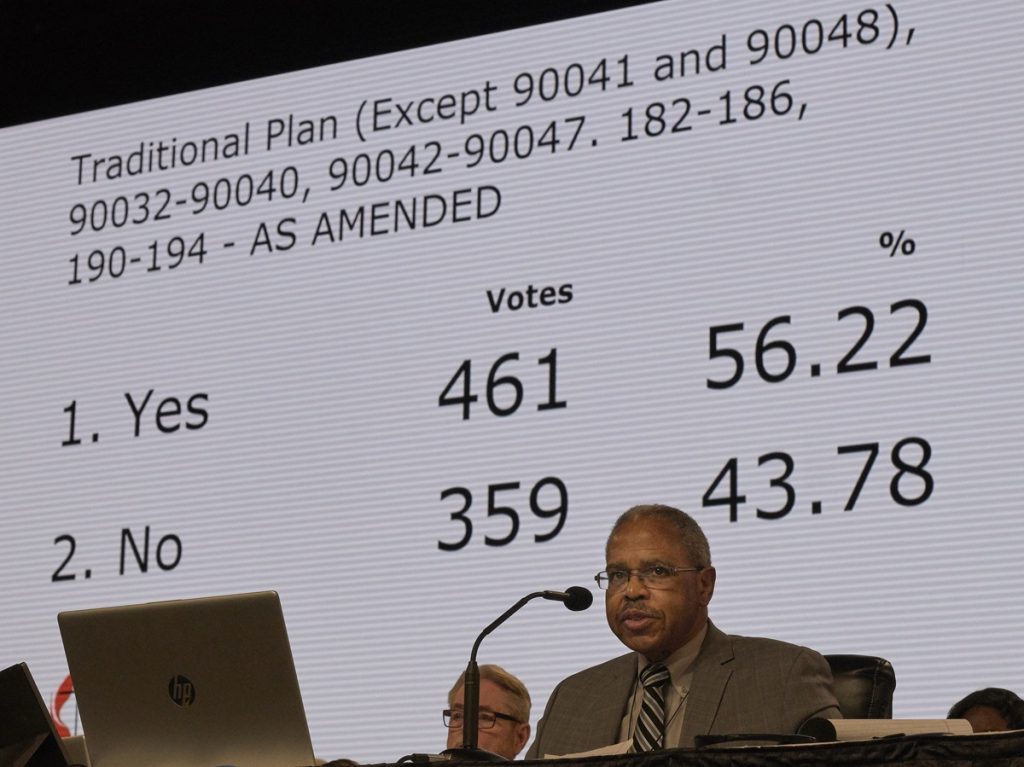
by Jon White
Much of my time earlier this week was taken up watching the United Methodist Church special conference called to address the place of LGBT+ persons in the life of that church. It was pretty clear from the get-go, that a clear majority were not there to find a way forward or to balance competing understandings of inclusion, but rather to claim a victory for their preferred vision. The other dominant story in my world was that of the scandal over invitations to the Lambeth conference and whose spouses were included and whose weren’t.
Let me state up front that I truly believe that the Holy Spirit is leading the people of God into an understanding that LGBT+ persons are meant to be included within God’s people. That includes marriage and ordination.
The Spirit continues to invite us into deeper relationship and a deeper understanding of just who our worthy “neighbor” might be. The issue of inclusion of our LGBT+ siblings is one of those invitations just as two centuries ago, the same the Holy Spirit led our antecedents to claim that slavery was incompatible with Christian life. This despite the fact that the Bible does not condemn slavery, but rather accepts it as part of the reality of human life and even offers regulation for it in the Hebrew Scriptures.
Reflecting on the UMC and its fracturing and the Lambeth pettiness, I sense that what might be at play are differing understandings of what exactly Jesus did for us. This conflict is rooted in differing ideas of what “salvation” is and how we should respond. In other words, we are seeing competing enactments of differing views of atonement.
Atonement is the one great unresolved doctrine of the church. No authoritative decision has ever been reached on what exactly or how exactly Jesus accomplishes our salvation. If the fellow students in my theology course at seminary were representative of the wider church, that the Atonement is not settled doctrine is something of a surprise to many.
The word Atonement is a mash-up of the words “at one” plus the suffix “-ment.” It describes the process by which God and Humanity become joined. There are multiple ideas and theories at play, and one could get a PhD just studying one tiny aspect of any of those, but to vastly simplify things there are three main competing ideas.
Likely the oldest is Ransom theory. Ransom theory originates in the ancient church. In this view of the matter, the essential problem that Jesus solves is that prior to the crucifixion, humanity was entirely under the power of Satan. What Jesus does is to offer Satan a swap, his life for the freedom of humanity. Satan takes the deal because that would grant him power over a person of the godhead, but since God’s power cannot be contained in the Satanic realm, humanity is freed from Satan’s yoke.
The one most American Christians have been taught is the Satisfaction theory; especially its sub-theory Penal Substitution. These ideas of the Atonement have origins only in the late Medieval period. The basic idea here is that because humans have turned so far away from God, they have gravely dishonored God. In order to restore the divine honor, only a great sacrifice – nay, only a perfect sacrifice – could possibly work. Jesus’ primary mission here is to be something of a scapegoat for our sins in order to satisfy the Father’s wrath.
The third primary stream of Atonement thought is the Moral Influence or Moral Exemplar theory. This idea of salvation also has an ancient pedigree and it posits that Jesus doesn’t so much change our state of being but rather offers an example of what’s possible. Jesus doesn’t need to haggle with the devil or satisfy a bloodthirsty divine father. Instead, by being fully human in the Incarnation, through the example of his life and death, and through his teachings, Jesus shows us what is possible. And by his gifting the Holy Spirit to the Church and through his resurrection (and our invitation to participate in it), we are encouraged and empowered to follow his example. We aren’t freed so much as shown that we were always free – if we only we would see it and claim it.
Satisfaction theory has been dominant among the inheritors of the Reformation, but oddly it is an idea that makes Easter redundant, it makes Jesus’ life, his teachings and command redundant. To accomplish this kind of salvation requires only that he die. If Herod had successfully murdered the baby Jesus with the other innocents, then Jesus could have accomplished his mission. Ransom theory has its own problems involving Jesus needing to trick Satan and doesn’t clearly require that Jesus lived the life he lived either.
Whatever we might claim intellectually or theoretically, how we live out our baptism enacts one of these ideas of atonement. Each of these, however, leads us to different responses to the world around us.
I would suggest that that full inclusion naturally flows from the Moral Influence understanding of Jesus’ salvific effort. We are all – ALL – invited to take up Jesus’ example and model our own lives after it. There are no barriers, no one is beyond Jesus’ invitation “follow me.” If Jesus’ life, and not just his death, matters and if it has anything to show us, then it cannot be made theoretically redundant. Perhaps Jesus didn’t need to die. He may have recognized that his death was likely, unavoidable even since the powers of darkness always recognize the power of God and work to subvert or defeat it. Jesus’ perfect human life shows though that those powers, ultimately, cannot overcome the authority of love or the power of grace, dignity, forgiveness, reconciliation, and hope.
So, getting back to the UMC and the conflicts across the Anglican Communion; if one thinks that Jesus was sent to his death because his Father’s pride could not be restored in any other way, then perhaps a judgmental rule-based Christianity makes sense? Would such a God really want to invite us into a deeper understanding of neighbor or would that God only be interested in our toeing the line? Perhaps the move to inclusion then is tantamount to sending Jesus to his death again and again. You become culpable and maybe even likely to suffer similarly from God’s wrath – just as Jesus did.
On the other hand, if you believe that we are active participants in the salvation of creation and that the example of Jesus’ life – where he recognized the individual dignity of all who he encountered and healed not because someone was perfectly following all the rules but because they recognized and acknowledged the power in Jesus’ simple acts of love – then how else could we respond but to also recognize individual dignity and to respond lovingly?
God’s creation, including humanity, was and remains fundamentally good. God’s dream is to restore the goodness which human brokenness, human sin, has sullied. God’s plan for rectifying the situation is to invite God’s people to live as though the goodness was already fully restored, just as Jesus did, and by doing so to influence and be an example to others that they too might join God’s people in restoring goodness, in building the kingdom of God here and now.
The Rev Jon M. White is Rector of St Luke’s Episcopal Church in Camillus, NY and co-produces the weekly podcast, the Subversive Undercroft
image: The Rev. Joe Harris presides over the legislative committee as the results of a vote approving the Traditional Plan as amended by 461-359 are displayed. Photo by Paul Jeffrey, UMNS.

